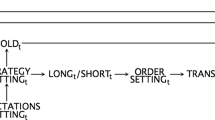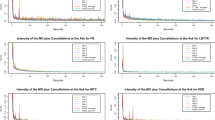Abstract.
Far-from-equilibrium models of interacting particles in one dimension are used as a basis for modelling the stock-market fluctuations. Particle types and their positions are interpreted as buy and sel orders placed on a price axis in the order book. We revisit some modifications of well-known models, starting with the Bak-Paczuski-Shubik model. We look at the four decades old Stigler model and investigate its variants. One of them is the simplified version of the Genoa artificial market. The list of studied models is completed by the models of Maslov and Daniels et al. Generically, in all cases we compare the return distribution, absolute return autocorrelation and the value of the Hurst exponent. It turns out that none of the models reproduces satisfactorily all the empirical data, but the most promising candidates for further development are the Genoa artificial market and the Maslov model with moderate order evaporation.
Similar content being viewed by others
References
The Economy as an Evolving Complex System, edited by P.W. Anderson, K.J. Arrow, D. Pines (Addison Wesley, Reading, 1988)
R.N. Mantegna, H.E. Stanley, Introduction to Econophysics: Correlations and Complexity in Finance (Cambridge University Press, Cambridge, 1999)
J.-P. Bouchaud, M. Potters, Theory of Financial Risks (Cambridge University Press, Cambridge, 2000)
F. Schweitzer (editor), Modeling Complexity in Economic and Social Systems (World Scientific, Singapore, 2002)
D. Challet, Y.-C. Zhang, Physica A 246, 407 (1997)
R.N. Mantegna, H.E. Stanley, Nature 376, 46 (1995)
Y. Liu, P. Cizeau, M. Meyer, C.-K. Peng, H.E. Stanley, Physica A 245, 437 (1997)
P. Gopikrishnan, M. Meyer, L.A.N. Amaral, H.E. Stanley, Eur. Phys. J. B 3, 139 (1998)
V. Plerou, P. Gopikrishnan, L.A.N. Amaral, M. Meyer, H.E. Stanley, Phys. Rev. E 60, 6519 (1999)
N. Vandewalle, M. Ausloos, Eur. Phys. J. B 4, 257 (1998)
E. Bacry, J. Delour, J.F. Muzy, Phys. Rev. E 64, 026103 (2001)
Z. Eisler, J. Kertész, Physica A 343, 603 (2004)
R. Liu, T. Di Matteo, T. Lux, e-print arXiv:0704.1338 (2007)
J.-P. Bouchaud, A. Matacz, M. Potters, Phys. Rev. Lett. 87, 228701 (2001)
F. Lillo, S. Mike, J.D. Farmer, Phys. Rev. E 71, 066122 (2005)
B. Biais, P. Hillion, C. Spatt, J. Finance 50, 1655 (1995)
S. Maslov, M. Mills, Physica A 299, 234 (2001)
D. Challet, R. Stinchcombe, Physica A 300, 285 (2001)
D. Challet , R. Stinchcombe, Physica A 324, 141 (2003)
X. Gabaix, P. Gopikrishnan, V. Plerou, H.E. Stanley, Nature 423, 267 (2003)
V. Plerou, P. Gopikrishnan, X. Gabaix, H.E. Stanley, Quant. Finance 4, C11 (2004)
V. Plerou, P. Gopikrishnan, H.E. Stanley, Phys. Rev. E 71, 046131 (2005)
B. Rosenow, Int. J. Mod. Phys. C 13, 419 (2002)
P. Weber, B. Rosenow, Quant. Finance 5, 357 (2005)
P. Weber, B. Rosenow, Quant. Finance 6, 7 (2006)
J.-P. Bouchaud, M. Mézard, M. Potters, Quantitative Finance 2, 251 (2002)
M. Potters, J.-P. Bouchaud, Physica A 324, 133 (2003)
J.-P. Bouchaud, Y. Gefen, M. Potters, M. Wyart, Quant. Finance 4, 176 (2004)
J.-P. Bouchaud, J. Kockelkoren, M. Potters, Quant. Finance 6, 115 (2006)
M. Wyart, J.-P. Bouchaud, J. Kockelkoren, M. Potters, M. Vettorazzo, e-print physics/0603084 (2006)
I. Zovko, J.D. Farmer, Quant. Finance 2, 387 (2002)
F. Lillo, J.D. Farmer, R.N. Mantegna, e-print cond-mat/0207428
F. Lillo, J.D. Farmer, R.N. Mantegna, Nature 421, 129 (2003)
J.D. Farmer, L. Gillemot, F. Lillo, S. Mike, A. Sen, Quant. Finance 4, 383 (2004)
J.D. Farmer, P. Patelli, I.I. Zovko, Proc. Natl. Acad. Sci. U.S.A. 102, 2254 (2005)
A. Ponzi, F. Lillo, R.N. Mantegna, e-print physics/0608032 (2006)
J.D. Farmer, N. Zamani, Eur. Phys. J. B 55, 189 (2007)
J.D. Farmer, A. Gerig, F. Lillo, S. Mike, Quant. Finance 6, 107 (2006)
F. Lillo, Eur. Phys. J. B 55, 453 (2007)
E. Scalas, T. Kaizoji, M. Kirchler, J. Huber, A. Tedeschi, Physica A 366, 463 (2006)
J.D. Farmer, F. Lillo, Quant. Finance 4, C7 (2004)
Y.-C. Zhang, Physica A 269, 30 (1999)
A.W. Lo, A.C. MacKinlay, J. Zhang, J. Financial Economics 65, 31 (2002)
X. Gabaix, P. Gopikrishnan, V. Plerou, H.E. Stanley, Physica A 324, 1 (2003)
G.J. Stigler, J. Business 37, 117 (1964)
D.K. Gode, S. Sunder, J. Political Economy 101, 119 (1993)
P. Bak, M. Paczuski, M. Shubik, Physica A 246, 430 (1997)
P.L. Krapivsky, Phys. Rev. E 51, 4774 (1995)
G.T. Barkema, M.J. Howard, J.L. Cardy, Phys. Rev. E 53, 2017 (1996)
D. Eliezer, I.I. Kogan, e-print cond-mat/9808240
L.-H. Tang, G.-S. Tian, Physica A 264, 543 (1999)
M. Raberto, S. Cincitti, S.M. Focardi, M. Marchesi, Physica A 299, 319 (2001)
S. Cincotti, S.M. Focardi, M. Marchesi, M. Raberto, Physica A 324, 227 (2003)
M. Raberto, S. Cincotti, Physica A 355, 34 (2005)
M. Raberto, S. Cincotti, S.M. Focardi, M. Marchesi, Computational Economics 22, 255 (2003)
M. Raberto, S. Cincotti, C. Dose, S.M. Focardi, M. Marchesi, in Nonlinear Dynamics and Heterogeneous Interacting Agents, edited by T. Lux, S. Reitz, E. Samanidou 305 (Springer, Berlin, 2005)
S. Cincotti, S.M. Focardi, L. Ponta, M. Raberto, E. Scalas, in The Complex Network of Economic Interactions, edited by A. Namatame, T. Kaizouji, Y. Aruka, 239 (Springer, Berlin, 2006)
R. Cont, J.-P. Bouchaud, Macroeconomic Dynamics 4, 170 (2000)
S. Maslov, Physica A 278, 571 (2000)
F. Slanina, Phys. Rev. E 64, 0561136 (2001)
S. Maslov, private communication
E. Smith, J.D. Farmer, L. Gillemot, S. Krishnamurthy, Quant. Finance 3, 481 (2003)
M.G. Daniels, J.D. Farmer, G. Iori, E. Smith, e-print cond-mat/0112422
M.G. Daniels, J.D. Farmer, L. Gillemot, G. Iori, E. Smith, Phys. Rev. Lett. 90, 108102 (2003)
G. Iori, M.G. Daniels, J.D. Farmer, L. Gillemot, S. Krishnamurthy, E. Smith, Physica A 324, 146 (2003)
S. Mike, J.D. Farmer, J. Economic Dynamics and Control 32, 200 (2008)
D. Challet, R. Stinchcombe, e-print cond-mat/0208025
R. Stinchcombe, in Econophysics and Sociophysics: Trends and Perspectives, edited by B.K. Chakrabarti, A. Chakraborti, A. Chatterjee (Wiley-VCH, Weinheim, 2006) pp. 35–63
T. Halpin-Healy, Y.-C. Zhang, Phys. Rep. 254, 215 (1995)
R.D. Willmann, G.M. Schütz, D. Challet, Physica A 316, 430 (2002)
M.F.M. Osborne, Econometrica 33, 88 (1965)
L. Kullmann, J. Kertész, Physica A 299, 234 (2001)
F. Franci, R. Marschinski, L. Matassini, Physica A 294, 213 (2001)
L. Matassini, F. Franci, Physica A 289, 526 (2001)
J.D. Farmer, S. Joshi, J. Economic Behavior and Organization 49, 149 (2002)
D. Challet, e-print physics/0608013 (2006)
L. Muchnik, F. Slanina, S. Solomon, Physica A 330, 232 (2003)
A. Svorenčík, F. Slanina, Eur. Phys. J. B 57, 453 (2007)
E. Scalas, in The Complex Network of Economic Interactions, edited by A. Namatame, T. Kaizouji, Y. Aruka (Springer, Berlin, 2006)
Author information
Authors and Affiliations
Corresponding author
Rights and permissions
About this article
Cite this article
Slanina, F. Critical comparison of several order-book models for stock-market fluctuations. Eur. Phys. J. B 61, 225–240 (2008). https://doi.org/10.1140/epjb/e2008-00059-3
Received:
Published:
Issue Date:
DOI: https://doi.org/10.1140/epjb/e2008-00059-3




